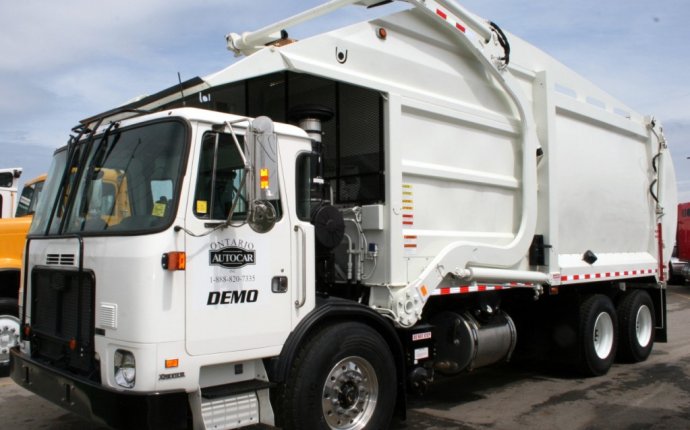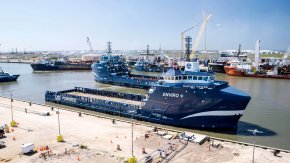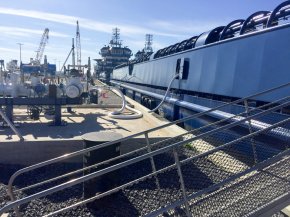
Garbage truck application
 Fuel is always a controversial topic in America. What should we use for fuel? How much will it cost? Where will we get it? What are the environmental consequences of our fuel choices? These are all politically loaded questions. But when it comes to fueling our trucks, ships and heavy equipment, natural gas is becoming an important part of the answer.
Fuel is always a controversial topic in America. What should we use for fuel? How much will it cost? Where will we get it? What are the environmental consequences of our fuel choices? These are all politically loaded questions. But when it comes to fueling our trucks, ships and heavy equipment, natural gas is becoming an important part of the answer.
“It’s cheap, it’s clean, it’s abundant, it’s domestic, ” says Chad Verret, executive vice president with Harvey Gulf International Marine. “It’s the only fuel that Democrats and Republicans can be hand-in-hand on. It’s ‘drill, baby, drill’ for the Republicans, and it’s clean and green for the Democrats.”
Harvey Gulf recently added to its fleet three offshore service vessels that mainly run on liquefied natural gas. Three more are under construction.
The company also has unveiled North America’s first marine LNG fueling terminal at its Port Fourchon operations headquarters, where Harvey Energy, the first American-flag vessel primarily powered by LNG, was loaded with 43, 000 gallons of LNG in January.
The LNG ships, which can use diesel as a backup fuel, cost about 20% more to build than a comparable non-LNG vessel, Verret says. But when design advantages and fuel costs are taken into account, they’re about 30% more efficient.
And while the LNG ships are cheaper to operate, for Shell, Harvey’s customer, the environmental benefits might be even more important. LNG has a smaller carbon footprint than diesel, and it helps operators abide by new standards on sulfur and nitrogen oxide emissions.
“Shell’s investment underlines our confidence in LNG becoming a bigger part of the global fuel mix, ” says John Hollowell, executive vice president for deep water with Shell Upstream Americas.
 LNG FOR HIGH HORSEPOWER
LNG FOR HIGH HORSEPOWER
Even while the kind of LNG fueling terminal Harvey Gulf has introduced at Port Fourchon is brand new, a coalition of marine industry stakeholders is at work on bringing LNG to much broader accessibility for marine use.
A “best of industry” team plans to make LNG widely available to ship owners as a propulsion fuel, MarineLog reported in December. The team, led by Siemens Drilling and Marine, Dresser-Rand and Lloyd’s Register, aims to provide an end-to-end solution, encompassing the entire supply chain, that will remove obstacles that can hold back widespread adoption of natural gas as the marine fuel of choice.
“Our integrated solution, encompassing the entire supply chain of LNG including gas-fueled marine propulsion systems, will remove the chicken-and-egg hurdle from the LNG-equation, ” says David Grucza, Siemens Drilling and Marine. “This is a disruptive concept for the maritime industry, and the technology exists for immediate adoption. This joint solution is not limited geographically, and we stand ready to support the marine industry globally, although our initial focus is on deploying U.S. shale gas.”
The service, which would initially be offered to the North American inland and coastal waterways community, combines a liquefaction barge, a bunkering (fueling) barge and a river pushboat to supply LNG-powered vessels with fuel.
Meanwhile, North America’s leading railroad giants continue to quietly test the waters with natural gas locomotive trials, Gladstein, Neandross & Associates reports. Companies are evaluating both GE and Caterpillar gas engines, while running pilot LNG locomotives across the country to assess their durability in diverse climates. Florida East Coast Rail began full-system, revenue-service trials of LNG, running GE dual-fuel locomotives between Jacksonville and Miami earlier this year, extending its previous trial route between Jacksonville and New Smyrna Beach, just south of Daytona.
“Experts predict that oil will rebound to $70 to $80/barrel in the near-term, ” writes Gladstein, Neandross & Associates CEO Erik Neandross. “With natural gas prices in the $2.50 -$3.00/MMBtu range, HHP [high horsepower] operators have an opportunity to save 30 to 50% on fuel costs. In addition, as we have seen from $2.00 – $4.00/MMBtu natural gas for the last seven years, the lack of volatility in the North American natural gas market provides significant budget predictability for large energy consumers well into the future.”
In the past year, the website HHP Insight [hhpinsight.com], has also reported on growing traction for LNG as a fuel for cruise boats, tankers, container carriers, tugs and towboats, heavy construction equipment, and mining and drilling. Tote Maritime, which brought the first LNG-fueled container ship into service between Florida and Puerto Rico last November, committed to LNG not because it’s cheaper, but because it’s cleaner, the website reported.
A GROWING SECTOR
For use as a transportation fuel, natural gas can be converted into LNG or compressed natural gas (CNG). Last year, transportation represented only about 0.13% of the overall consumption of natural gas in the United States, according to the U.S. Energy Information Administration.
“But it’s still one of the fastest-growing sectors out there, ” says David Dismukes, executive director and professor at LSU’s Center for Energy Studies.
That growth has been hampered lately by the relatively low cost of crude oil. But restrictions on sulfur emissions from diesel fuel, in effect for years on land vehicles, are just now starting to kick in for marine traffic, Dismukes says, so vessel owners and operators increasingly are looking to natural gas.
Lower gasoline prices mean the everyday car buyer is less likely to be interested in a natural gas-powered vehicle, says Matt Godlewski, president of Natural Gas Vehicles for America. However, some municipalities are moving toward natural gas-fueled buses, while AT&T, which deployed its 8, 000th CNG vehicle in 2014, probably has the largest light-duty natural gas fleet in the country, he says.
“Where we continue to see growth, and where there’s the greatest opportunity for growth in the future, is in the heavy-duty segment, where you’ve got high fuel use and high mileage, ” Godlewski says.









